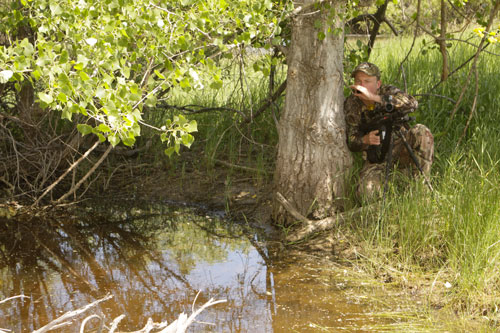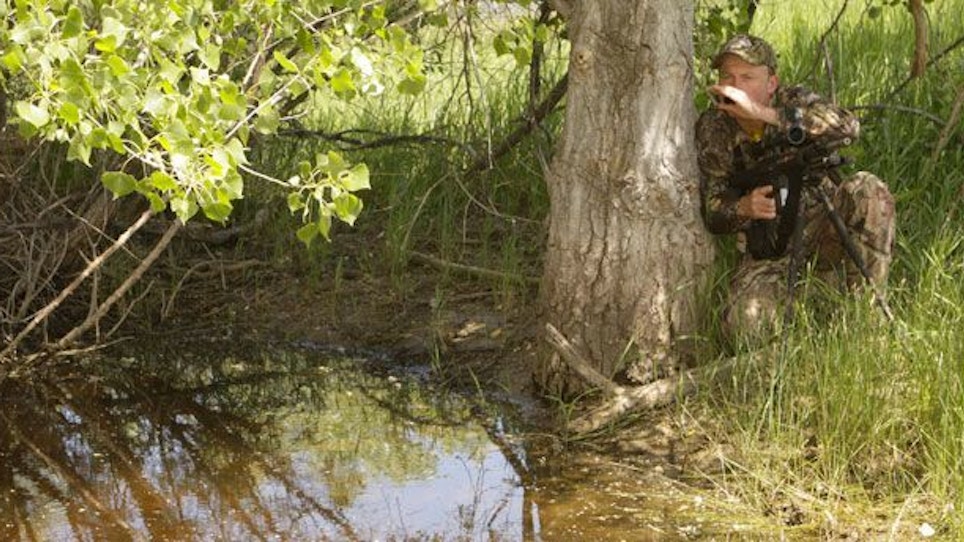I admit summer isn’t my favorite season to hunt coyotes. I don’t have anything against it, especially if you’re trying to manage an overabundance of coyotes to give young prey species a much-needed boost to adulthood. Tipping over hungry coyotes can help get a few more fawns and fowl to adulthood.
I just have too many irons in the fire to give a ton of attention to the dog days of summer. If you don’t mind the heat, bugs and humidity, summer coyotes can be as challenging and rewarding as a day at your local links.
As opportunists, coyotes focus on prey that is vulnerable and plentiful. During summer fawns fall into that very category and coyotes put them at the top of their dining menu in June and July. The same is true of any vulnerable species that a coyote might trip over while hunting—they have to feed their young, too.
Fortunately nature prepares for this predation by overwhelming the coyotes with a deluge of vulnerable prey all at once. Most fawns are dropped in a short window of time in early spring and after a month most have a good chance for escape if pursued.
Coyotes maintain their territories year-round, but you can micro focus your setups in summer by targeting habitats coyotes will be relying on for creature comforts.
First, think daycare. Depending on the time of summer, coyotes may still be near their den sites. As pups mature adults will be venturing farther and farther from the den, eventually abandoning it altogether as they teach young coyotes to hunt. Up until this point, dens will still be utilized and provide an ambush site to call near or simply watch for a sniper opportunity. If you’re in a hot coyote zone, get up high and glass slopes for signs of dens and listens at dawn and dusk for coyote parents communicating.
 Next, think shade. After the sun comes up and coyotes retire from their nocturnal-heavy travel pattern, they’ll look for shady locations to bed up for the day. In the desert and openness of the West shade can come in the form of steep banks, cholla plants, sagebrush and the occasional juniper. In the East shade is everywhere so you may want to skip this portion of the article. Nevertheless, think cool, shady locations that coyotes can use to escape the heat.
Next, think shade. After the sun comes up and coyotes retire from their nocturnal-heavy travel pattern, they’ll look for shady locations to bed up for the day. In the desert and openness of the West shade can come in the form of steep banks, cholla plants, sagebrush and the occasional juniper. In the East shade is everywhere so you may want to skip this portion of the article. Nevertheless, think cool, shady locations that coyotes can use to escape the heat.
Look for water. Again, some locations will be water-rich, but in others coyotes will likely be near water for a quick pick-me-up. One study I recall noted that most dens were within 1 mile of water, if not closer. Another avid coyote hunter I interviewed said he always finds more fawn kills near water and he links those directly back to coyotes. Coyotes aren’t camels so they need to drink and drink often. Think of how much your own dog waters on a hot day. If water is scarce, set up near it for a coyote encounter.
Lastly, think food. Although babies provide a plethora of food for hungry coyotes, some areas produce more than others. Ungrazed grasslands, traditional fawning areas, and thickets full of rodents are all targets for coyotes trying to raise pups. If you know of an area with high prey species now is a good time to set up near it to call in a summer coyote.
Summertime coyotes respond to both prey-in-distress calls and coyote vocalizations as they defend homelands, and pups from invaders. If you don’t fish, golf or waterski, summer-coyote hunting may be to your liking. Just don’t forget the sunscreen.






